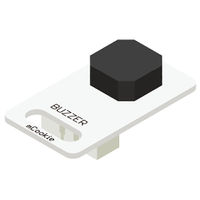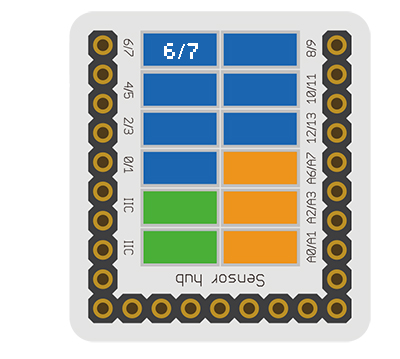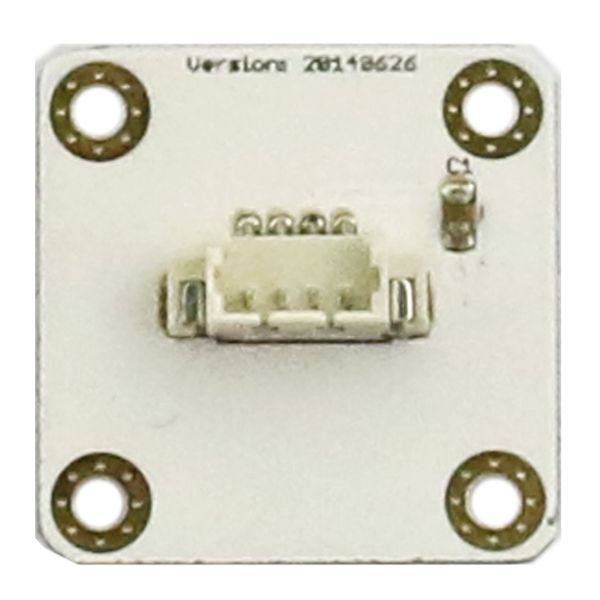Difference between revisions of "Sensor-Buzzer"
m (Fengfeng moved page Microduino-Buzzer to Sensor-Buzzer) |
(→Usage) |
||
| (16 intermediate revisions by 2 users not shown) | |||
| Line 1: | Line 1: | ||
{{Language|Microduino-Buzzer}} | {{Language|Microduino-Buzzer}} | ||
| − | {| style="width: | + | {| style="width: 80%;" |
|- | |- | ||
| | | | ||
| − | [[File: Microduino-BUZZER.jpg|400px|thumb|right| | + | [[File: Microduino-BUZZER-v1.jpg|400px|thumb|right| Sensor-Buzzer]] |
| − | |||
| + | The product number of Sensor-Buzzer is: '''MSDO11''' | ||
| + | Sensor-Buzzer is a passive buzzer. Like a magnetic speaker, it needs voltage with different frequency so that it can make sound accordingly. The pitch becomes louder when the frequency gets higher. | ||
| + | ==Introduction of Pins== | ||
| + | {{ST_Pinout | ||
| + | |st_name=Buzzer | ||
| + | |pin3=Digital Output | ||
| + | }} | ||
| − | == | + | ==Features== |
*Controllable sound frequency (eg: You can achieve the effect of piano spectrum with it. ) | *Controllable sound frequency (eg: You can achieve the effect of piano spectrum with it. ) | ||
| − | *Small size | + | *Small size which is easy to install. |
==Specification== | ==Specification== | ||
| − | * | + | *Voltage |
| − | + | **3.3V~5V working voltage | |
| + | *Size | ||
| + | **Size of the board: 23.5mm*13mm | ||
| + | **1.27mm-spacing 4Pin interface connected with sensorhub. | ||
| + | **The CAD drawing of the sensor: '''[[File:Sensor_CAD.zip]]''' | ||
| + | |||
| + | *Technical parameters | ||
| + | **Drive with 2K~5K square wave | ||
| + | **The sound frequency is controllable. | ||
| + | |||
| + | *Connection | ||
| + | **This sensor can be connected to the following interfaces of core: '''A0~A7''','''D2~D13''' | ||
| − | |||
==Document== | ==Document== | ||
| − | * | + | *Schematic diagram: '''[[File: Sensor-Buzzer.Zip]]''' |
| + | |||
| + | ==Usage== | ||
| + | |||
| + | ===Basic Functionality=== | ||
| + | The Buzzer Trinket is a simple trinket which emits sound when passed with a frequency. A Core module can control the frequency of the Buzzer output. | ||
| + | {| class="wikitable" | ||
| + | |+Buzzer Trinket State Table | ||
| + | |- | ||
| + | ! Pin State | ||
| + | ! Buzzer State | ||
| + | |- | ||
| + | |No Frequency | ||
| + | |No Buzzing | ||
| + | |- | ||
| + | |Frequency Present | ||
| + | |Buzzing | ||
| + | |} | ||
| + | |||
| + | ===Programming=== | ||
| + | <tab name="Arduino for Microduino" style="width:100%;"> | ||
| + | ==Introduction== | ||
| + | The Buzzed Trinket is used as an output pin. Special functions on the Core module is used to generate a frequency signal to the Buzzer. | ||
| + | ==Key Functions== | ||
| + | *Required Libraries: None | ||
| + | *Key Functions: | ||
| + | ** '''tone(pin_number, frequency)''' - starts generating a frequency signal on the pin, will not stop until noTone(pin_number) is called '''([https://www.arduino.cc/en/Reference/Tone Read more])''' | ||
| + | ***'''pin_number''' - is the pin number that the trinket is connected to | ||
| + | ***'''frequency''' - a frequency value to generate on the pin | ||
| + | ** '''noTone(pin_number)''' - stops generating a frequency on the pin '''([https://www.arduino.cc/en/Reference/noTone Read more])''' | ||
| + | ***'''pin_number''' - is the pin number that the trinket is connected to | ||
| + | ** '''tone(pin_number, frequency, duration)''' - generates a frequency signal on the pin for a set amount of time '''([https://www.arduino.cc/en/Reference/Tone Read more])''' | ||
| + | ***'''pin_number''' - is the pin number that the trinket is connected to | ||
| + | ***'''frequency''' - a frequency value to generate on the pin | ||
| + | ***'''duration''' - the duration in milliseconds to generate the frequency signal | ||
| + | |||
| + | ==Example== | ||
| + | This is a simple example which: | ||
| + | *Starts the Buzzer at a 440hz frequency. | ||
| + | *Waits 1 second. | ||
| + | *Turns off the Buzzer. | ||
| + | *Wait 1 second. | ||
| + | *Runs the Buzzer at a 294hz frequency for 2 seconds | ||
| + | *Waits 5 seconds. | ||
| + | |||
| + | '''Note''': Important lines of code are highlighted. | ||
| − | == | + | <syntaxhighlight lang="cpp" highlight="1,2,14,15,18,19,24,25"> |
| − | + | //Define the pin the buzzer is connected to | |
| − | + | const int BUZZER_PIN = 6; | |
| − | + | ||
| − | + | void setup() { | |
| − | + | // put your setup code here, to run once: | |
| − | + | ||
| − | + | //Initial serial communication port at 9600 baud | |
| − | + | Serial.begin(9600); | |
| − | void setup() | ||
| − | |||
| − | |||
} | } | ||
| − | |||
| − | |||
| − | |||
| − | |||
| − | |||
| − | |||
| − | + | void loop() { | |
| − | + | // put your main code here, to run repeatedly: | |
| − | delay(1000); | + | |
| − | + | //Start the Buzzer with a 440hz frequency | |
| − | + | tone(BUZZER_PIN, 440); | |
| − | + | //Wait 1 second | |
| − | + | delay(1000); | |
| − | + | //Turn off the Buzzer | |
| + | noTone(BUZZER_PIN); | ||
| + | |||
| + | //Wait 1 second | ||
| + | delay(1000); | ||
| + | |||
| + | //Run the Buzzer with a 294hz frequency for 2000 milliseconds (2 seconds) | ||
| + | tone(BUZZER_PIN, 294, 2000); | ||
| + | |||
| + | //Wait 5 seconds | ||
| + | delay(5000); | ||
} | } | ||
| − | </ | + | </syntaxhighlight> |
| − | + | Copy and paste the code above to the Arduino IDE or | |
| − | + | Download the above example: n/a | |
| − | + | </tab> | |
| + | ===Program Download=== | ||
| + | *Download and unzip the program '''[[File:Sensor-Buzzer_Test.zip]]''' | ||
| + | |||
| + | ===Programming=== | ||
| + | {{Upload | ||
| + | |nameA=[[Microduino-Core]], [[Microduino-USBTTL]] | ||
| + | |nameB=[[Microduino-USBTTL]] | ||
| + | |boardName=Microduino/mCookie-Core(328p), Atmega328P@16M,5V | ||
| + | |fileName=Sensor-Buzzer Test.ino | ||
| + | }} | ||
| + | |||
| + | ===Hardware Setup=== | ||
| + | *Referring to the following diagram, connect the Sensor-Buzzer to digital pin D6 of '''[[Microduino-Sensorhub]]'''. | ||
| + | <br> | ||
| + | [[file:Microduino-sensorhub_Shake.JPG|thumb|400px|left]] | ||
| + | <br style="clear: left"/> | ||
| + | |||
| + | ===Result=== | ||
| + | *After download, you can hear the alarming sound. | ||
| + | |||
| + | ==Application== | ||
| + | The buzzer can produce many weird sound. Maybe you can add some keys to it to compose a piece of wonderful music. | ||
| + | |||
| + | ===Projects=== | ||
| + | * '''[[Buzzer]]''' | ||
| + | * '''[[Touch Button]]''' | ||
| + | * '''[[Usage of Light Sensor]]''' | ||
| + | * '''[[PIR]]''' | ||
| + | * '''[[Use of Joystick]]''' | ||
| + | |||
| + | ==Purchase== | ||
| + | |||
| + | ==History== | ||
| + | |||
| + | ==Gallery== | ||
| + | {| border="0" cellpadding="10" width="100%" | ||
| + | |- | ||
| + | |width="50%" valign="top" align="left"| | ||
| + | [[file: Microduino-Buzzer-F1.JPG|thumb|400px|center|Sensor-Buzzer Front]] | ||
| + | |width="50%" valign="top" align="left"| | ||
| + | [[file: Microduino-Buzzer -b1.JPG|thumb|400px|center|Sensor-Buzzer Back]] | ||
| + | |} | ||
| + | |} | ||
==Purchase== | ==Purchase== | ||
Latest revision as of 20:15, 18 August 2017
| Language: | English • 中文 |
|---|
|
The product number of Sensor-Buzzer is: MSDO11 Sensor-Buzzer is a passive buzzer. Like a magnetic speaker, it needs voltage with different frequency so that it can make sound accordingly. The pitch becomes louder when the frequency gets higher. ContentsIntroduction of Pins
Features
Specification
Document
UsageBasic FunctionalityThe Buzzer Trinket is a simple trinket which emits sound when passed with a frequency. A Core module can control the frequency of the Buzzer output.
ProgrammingIntroductionThe Buzzed Trinket is used as an output pin. Special functions on the Core module is used to generate a frequency signal to the Buzzer. Key Functions
ExampleThis is a simple example which:
Note: Important lines of code are highlighted. //Define the pin the buzzer is connected to
const int BUZZER_PIN = 6;
void setup() {
// put your setup code here, to run once:
//Initial serial communication port at 9600 baud
Serial.begin(9600);
}
void loop() {
// put your main code here, to run repeatedly:
//Start the Buzzer with a 440hz frequency
tone(BUZZER_PIN, 440);
//Wait 1 second
delay(1000);
//Turn off the Buzzer
noTone(BUZZER_PIN);
//Wait 1 second
delay(1000);
//Run the Buzzer with a 294hz frequency for 2000 milliseconds (2 seconds)
tone(BUZZER_PIN, 294, 2000);
//Wait 5 seconds
delay(5000);
}Copy and paste the code above to the Arduino IDE or Download the above example: n/a Program Download
Programming
Hardware Setup
Result
ApplicationThe buzzer can produce many weird sound. Maybe you can add some keys to it to compose a piece of wonderful music. ProjectsPurchaseHistoryGallery
|
Purchase
History
Image
- Front
- Back




